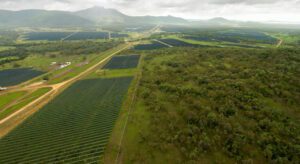The establishment of a renewable energy-powered “green” steel industry in Australia would generate tens of thousands of jobs and an export market comparable to Australia’s coal industry of today, a new report has found.
Perhaps even more impressively, the Grattan Institute report argues that a renewables-based steel industry could solve Australia’s “climate policy conundrum,” by balancing strong action on global warming with the interests of the nation’s regional communities and “carbon workers.”
The 57-page research paper, published on Sunday, is the latest in a series of roadmaps and industry-led brainstorming sessions designed to chart a renewable energy-based recovery from the current Covid-19 economic downturn.
It assesses the potential of three sectors to help make Australia a green energy superpower – aviation fuel, ammonia, and steel – and settles on ‘green’ (near-zero emissions) steel as the largest and most economically viable opportunity.
“A range of clean energy industries could plausibly provide hundreds, or even thousands, of new jobs in Australia,” the report says. “But very few can plausibly provide tens of thousands of jobs, comparable to the number in [Australia’s] key coal mining regions.
“Green steel is the exception.”
Just as Ross Garnaut described in last week’s Stimulus Summit, co-hosted by the Smart Energy Council and RenewEconomy, the idea is that steel manufacturing using solar and wind could both revive Australian manufacturing, and value-add renewables by using them to process export goods.
“Australia’s abundant solar and wind resources are well suited to making hydrogen, the key energy input to making green steel from renewable energy,” the Grattan Institute report says.
“And Australia’s lower-cost green hydrogen will make it a better place to produce green steel than places like Japan or Indonesia.”
The report sees Australia cornering just under 7 per cent of the global market for green steel production and export, but notes that this will require strong support from governments – starting immediately – and investment by international steel companies.
“Significant investment – almost $A200 billion in today’s dollars – would be required for Australia to produce almost 7 per cent of the world’s green steel,” the report says.
“This amount of investment is large, but is much less than the $350 billion invested in Australia by the oil and gas industry in the past decade alone.”
And, it continues, “the economic prize is substantial. The annual output of a green steel industry of this scale would be about $65 billion in today’s dollars. This is only slightly smaller than the value of Australia’s export coal industry today.”
The other major prize – this one invaluable – could be to bridge the political impasse Australia seems to have been stuck at for the better part of the past decade, by setting a path for credible, tangible climate action, while keeping voters (and the political far right) on-side.
The report argues that the key failure of Australian climate politics – and the probable cause of the federal Labor opposition’s inability to win what looked like an unlosable election in 2019 – has been its failure to address the concerns of the nation’s “carbon workers.”
According to the Grattan Institute, Australia has close to 100,000 “carbon workers,” which the report defines as employees of carbon-intensive industries such coal mining, oil and gas extraction, fossil fuel electricity generation, cement manufacture and steel making.
Notably, the federal Coalition has been no better in its treatment of these carbon workers, who the report says deserve honesty about the ability of Australian governments to ‘protect’ their jobs.
“The future of Australia’s carbon-intensive industries, particularly coal mining, will be determined primarily in Beijing and New Delhi, not in Canberra,” it says.
“The government’s current approach – modest domestic emissions reduction targets – will not effectively protect jobs in the face of global climate action. Nor does it help capture the economic opportunities Australia might have in a decarbonised world. This ultimately works against Australia’s national interest.
“A better approach is economic diversification, particularly into new industries based on zero-emissions energy.”
The Grattan Institute calls on the federal government to get to work on helping Australian steel-making move to lower-emissions technologies over the next decade.
This should include funding for a steel ‘flagship’ project that would underpin investment in lower-emissions technologies and build the skills and capabilities required to create an export-scale green steel industry.
Meanwhile, governments at every level should continue their efforts to build capability in making and storing hydrogen, the report says, consistent with the National Hydrogen Strategy.
“This exciting, credible opportunity for Australia will not be delivered in 2020, but it can be shaped over the next few years,” the report says. “The hard work must begin now.”
“‘For too long, adding value to Australia’s energy and minerals resources and creating sustainable jobs through manufacturing and exporting have been the stuff of dreams,” said Grattan Institute’s Energy Program director and report lead author Tony Wood.
“Not anymore. If we get this right, we will resolve the great climate conundrum that has stretched our political fabric for more than a decade,” he said.
RenewEconomy and its sister sites One Step Off The Grid and The Driven will continue to publish throughout the Covid-19 crisis, posting good news about technology and project development, and holding government, regulators and business to account. But as the conference market evaporates, and some advertisers pull in their budgets, readers can help by making a voluntary donation here to help ensure we can continue to offer the service free of charge and to as wide an audience as possible. Thank you for your support.









